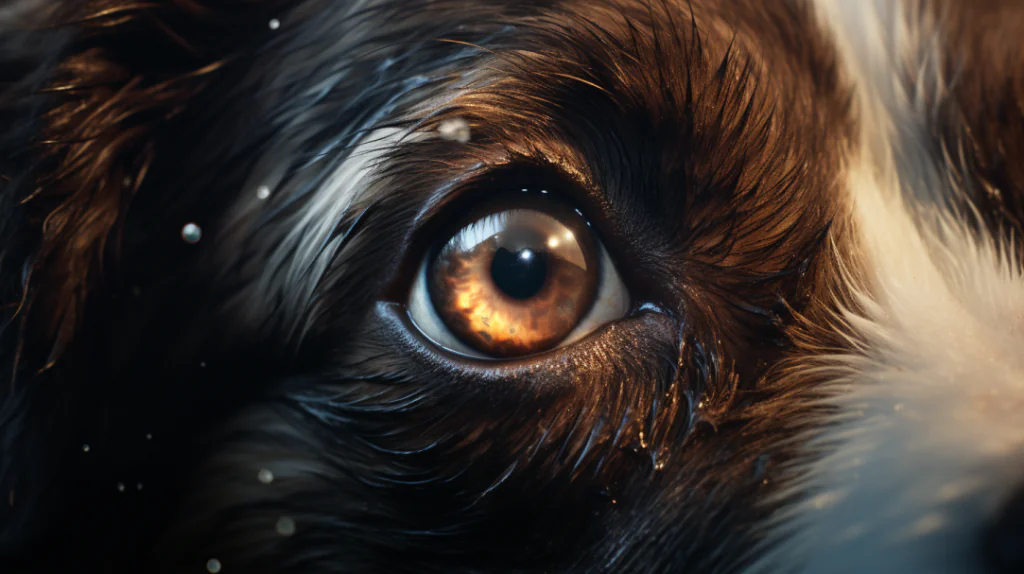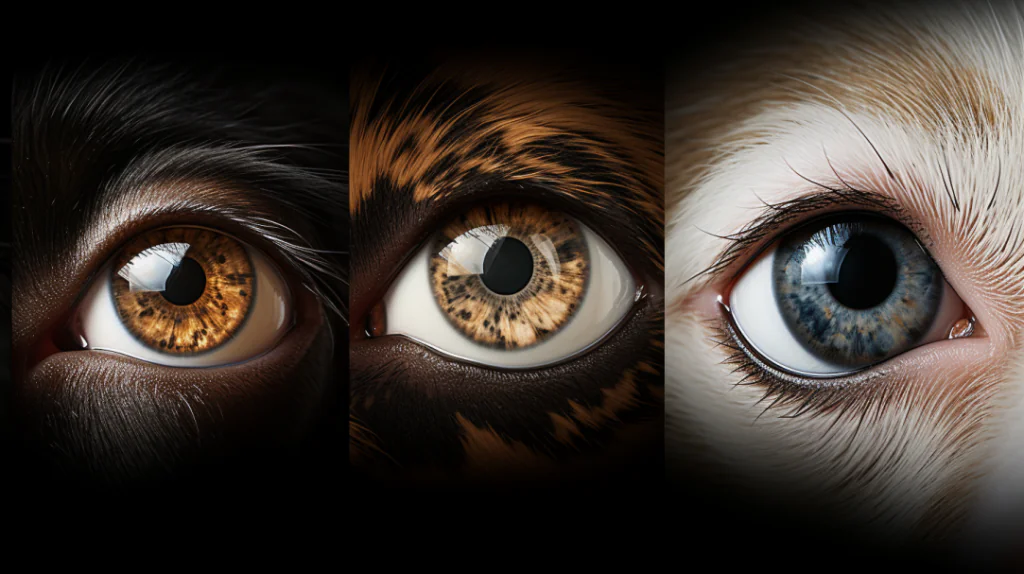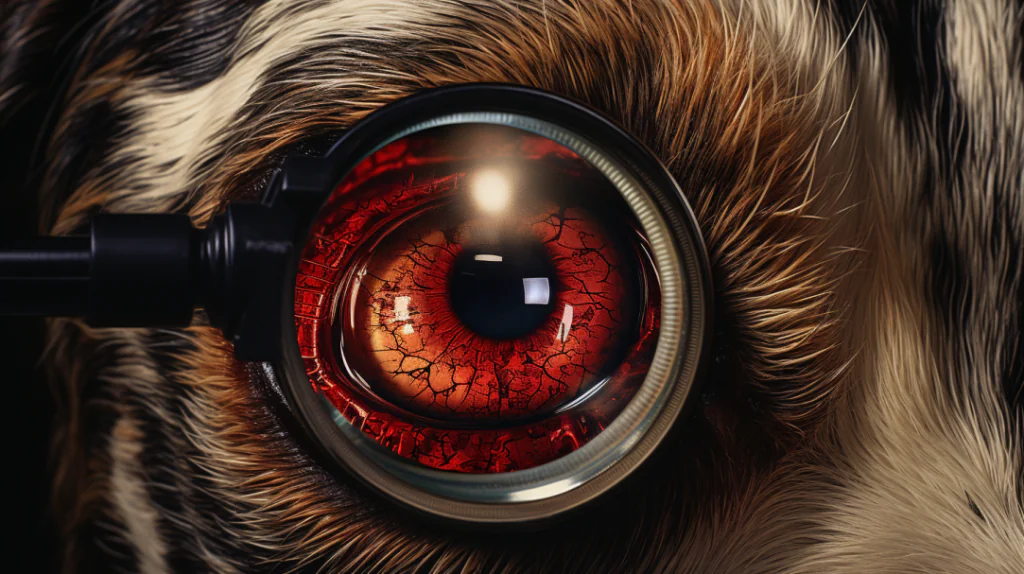Table of Contents
Are you worried about your diabetic dog losing their vision? Do diabetic dogs go blind? Discovering the connection between diabetes and blindness in dogs is crucial for understanding the risks and taking proactive steps.
Diabetic dogs are at a higher risk of developing cataracts, a common side effect of diabetes. Shockingly, around 75% of diabetic dogs develop cataracts within the first year of diagnosis. If left untreated, cataracts can lead to blindness.
Detecting and treating cataracts early is vital. Regular vet check-ups are crucial for catching cataracts in the early stages.
This article will explore cataract development, treatment options, and the importance of veterinary visits. Stay informed to manage your dog’s diabetes and potentially prevent blindness.
Key Takeaways
- 75% of diabetic dogs develop cataracts within the first year of diagnosis
- Cataracts in diabetic dogs can lead to eventual blindness if left untreated.
- Early detection and treatment of cataracts can help prevent or delay their formation.
- Regular veterinary check-ups are crucial for detecting cataracts in the early stages.
What is Diabetes?
Diabetes is a medical condition that affects dogs just as it affects humans. It occurs when the body cannot properly regulate blood glucose levels. This can lead to a range of health issues, including vision problems. Dogs with diabetes are at risk of developing diabetic cataracts, which can cause vision loss and, in severe cases, blindness.
The excess glucose in the blood of diabetic dogs can damage the blood vessels in the eyes, leading to the development of cataracts. Cataracts form when the usually transparent lens of the eye becomes cloudy. As the cataracts progress, they can cause blurred vision and, eventually, total vision loss.
Early diagnosis and proper management of diabetes are essential in minimizing the risk of vision loss in dogs. Treatment options for diabetic cataracts include surgery to remove the cloudy lens and restore vision.
While blindness can be a complication of diabetes in dogs, with proper medical care and regular monitoring, many diabetic dogs can maintain their vision. Dog owners need to work closely with their veterinarian to manage diabetes and prevent the development of vision problems.
Do Diabetic Dogs Go Blind?
Yes, diabetes in dogs can lead to blindness. Excess glucose in the blood of diabetic dogs can damage the blood vessels in the eyes, ultimately leading to the development of cataracts. Cataracts occur when the usually transparent eye lens becomes cloudy, causing blurred vision and total loss of sight if left untreated.
Early diagnosis and proper management of diabetes are crucial in minimizing the risk of vision loss. Treatment options for diabetic dogs with cataracts include cataract surgery, which involves removing the cloudy lens to restore vision.
It is essential to monitor blood glucose levels and provide appropriate medical care to diabetic dogs to prevent the development of cataracts and subsequent blindness. By managing their diabetes effectively, owners can help their furry companions maintain their eyesight and overall quality of life.
Prevalence of Cataracts in Diabetic Dogs
Diabetic dogs have a high prevalence of cataracts, which can lead to blindness and vision loss. Studies have shown that approximately 75% of diabetic dogs develop cataracts within the first year of diagnosis. Compared to non-diabetic dogs, diabetic dogs are more prone to developing cataracts.
Cataracts in diabetic dogs result from sugar accumulation on the eye lens, causing clouding and obstruction of vision. If left untreated, cataracts can progress through stages, from incipient cataracts with minimal impact on the image to mature cataracts with complete vision loss. Hyper-mature cataracts can lead to wrinkling and shriveling of the lens, where surgery becomes the only option for preserving vision.
Regular veterinary check-ups are crucial for early detection and treatment of diabetic cataracts to prevent or delay blindness in diabetic dogs.
Impact of Cataracts on Vision

Cataracts in diabetic dogs can have a significant impact on their vision. Approximately 75% of diabetic dogs develop cataracts within the first year of diagnosis, and if left untreated, these cataracts can lead to eventual blindness.
The development and progression of cataracts in diabetic dogs are influenced by excess glucose in the lens. This excess glucose causes swelling, degeneration of lens fibers, and the formation of protein clumps. These protein clumps disrupt clarity and deform the lens structure.
Cataracts and Visual Impairment
If your dog has diabetes, it’s essential to understand cataracts’ impact on their vision. Cataracts are one of the most prevalent side effects of diabetes in dogs, with approximately 75% of diabetic dogs developing cataracts within the first year of diagnosis. Left untreated, cataracts can lead to blindness.
Diabetic dogs are more prone to developing cataracts than non-diabetic dogs, making regular veterinary check-ups crucial for early detection. Cataracts progress through stages, from incipient to mature and hyper-mature, with each step impacting vision differently. Complications of advanced cataracts include lens-induced uveitis, glaucoma, and retinal detachment, which can cause permanent blindness.
Treatment options for cataracts in diabetic dogs include surgery and topical medications, but not all dogs will qualify for surgery.
Stages of Cataract Development

Let’s now delve into the stages of cataract development in diabetic dogs.
Cataracts progress from the embryonic stage, where only a tiny portion of the lens is affected, to the hyper-mature stage, characterized by lens breakdown and increased risk of complications.
The impact on vision varies throughout these stages, with the mature location resulting in complete obstruction of light and reduced picture.
Understanding these stages is crucial for timely intervention and treatment to preserve the dog’s sight.
Progression of Cataracts
The progression of cataracts in diabetic dogs involves distinct stages, each with varying impacts on vision. Understanding the steps can help dog owners recognize the signs and seek proper treatment.
Here are the stages of cataract development in diabetic dogs:
- Incipient cataracts: In this stage, there’s a slight clouding of the eye, but it has minimal impact on vision.
- Immature cataracts: Cataracts affect 15-100% of the lens, but light can still pass through. Vision may be impaired to varying degrees.
- Mature cataracts: The lens is entirely clouded, obstructing light and causing significant vision loss.
- Hyper-mature cataracts: The lens breaks down, leading to complications like lens-induced uveitis, glaucoma, and retinal detachment. These can cause permanent blindness and are painful for the dog.
Recognizing the stage of cataracts is crucial for determining the appropriate treatment approach. Regular veterinary check-ups can help detect cataracts in their early stages and prevent further progression.
Surgical Options for Cataracts?
Consider surgical options for cataracts in diabetic dogs based on the stages of cataract development. Cataracts progress through stages: incipient, immature, mature, and hyper-mature.
- In the embryonic stage, only 15% of the lens is affected, resulting in minimal impact on vision.
- As cataracts progress to the immature stage, they can affect 15-100% of the lens but still allow light to pass through.
- The lens is fully affected at the mature stage, causing total vision loss.
- In the hyper-mature stage, the lens breaks down, leading to complications and an increased risk of permanent blindness.
- Surgical intervention becomes the only option for vision preservation.
- It’s essential to consult with a veterinarian to determine the most suitable treatment approach based on the stage of cataract formation in diabetic dogs.
- Early detection and treatment are crucial in preventing irreversible vision loss.
Importance of Early Detection and Treatment

Please don’t overlook the crucial role of early detection and treatment when managing diabetes-related blindness in dogs. Diabetic dogs are prone to developing cataracts, leading to vision loss if left untreated. Here are four reasons why early detection and treatment are essential for maintaining eye health in diabetic dogs:
- Timely intervention: Detecting cataracts early allows for prompt medical management, which can help prevent or delay the condition’s progression.
- Preserving vision: Early treatment can prevent further vision loss and improve the chances of keeping sight in diabetic dogs.
- Collaborating with a veterinarian: Regular veterinary check-ups are essential for diagnosing cataracts and developing a suitable treatment plan. Veterinarians can guide in managing diabetes and preventing associated complications.
- Overall well-being: By prioritizing early detection and treatment, diabetic dogs can enjoy improved eye health, leading to a better quality of life.
Treatment Options for Diabetic Cataracts
When it comes to treating diabetic cataracts in dogs, there are both surgical and non-surgical options to consider.
- Surgery, such as phacoemulsification, can effectively remove cataracts and replace the lens, but not all dogs may qualify for this procedure.
- Non-surgical approaches, such as dietary changes and topical medications, can also effectively manage cataracts and prevent further vision loss.
- Early intervention is crucial to maximize treatment success and preserve the dog’s sight.
Surgical Vs. Non-Surgical Treatments
When it comes to treating diabetic cataracts in dogs, surgical and non-surgical options are available. Here are the main treatment options for diabetic cataracts:
Surgical Treatments:
- Phacoemulsification: This is the most common surgical procedure for treating cataracts in diabetic dogs. It involves removing the clouded lens and replacing it with an artificial lens. This surgery can restore vision in dogs with cataracts.
- Extracapsular Extraction: This surgical technique is used for more advanced cataracts. It involves removing the entire lens, including the capsule, and replacing it with an artificial lens. It’s a more invasive procedure but can still restore vision.
Non-Surgical Treatments:
- Medications: In some cases, medications can help manage inflammation or high intraocular pressure associated with diabetic cataracts. These medications can slow down the progression of cataracts and provide some relief to the dog.
- Diet and Insulin Management: For diabetic dogs, managing blood glucose levels through a balanced diet and insulin intake can help prevent or delay the development of cataracts. This approach addresses the underlying cause of cataracts and can be effective in some cases.
It is essential to consult with a veterinarian to determine the best treatment approach for your diabetic dog with cataracts. They’ll consider the severity of the cataracts, the overall health of the dog, and other individual factors to make an informed decision.
Role of Regular Veterinary Visits
@ Processed: /imagine prompt:Prompt: Illustrate a dog owner and a veterinarian engaged in a thorough eye examination, with the veterinarian meticulously examining the dog’s eyes using an ophthalmoscope, showcasing the importance of regular veterinary visits in preventing canine diabetes-related blindness. –v 5.2 –ar 16:9
Regular veterinary visits play a crucial role in managing and preventing vision loss in diabetic dogs. Diabetic dogs are more prone to developing cataracts, which can eventually lead to blindness if left untreated.
Regular check-ups with a veterinarian are essential for early detection of cataracts in their early stages. Timely intervention can prevent or delay the development of cataracts. Veterinarians can guide in managing diabetes and preventing associated complications, ensuring the overall health and well-being of diabetic dogs.
Collaboration with a veterinarian is crucial for effective management of cataracts. Regular veterinary visits allow for monitoring and controlling the progression of cataracts, ensuring proper treatment options are explored and helping to preserve the dog’s vision for as long as possible.
Factors on Dogs Going Blind From Diabetes
When it comes to dogs going blind from diabetes, understanding the factors at play is crucial for effective management and prevention.
Diabetes can cause blindness in dogs due to the development of cataracts, one of the disease’s most prevalent side effects. Approximately 75% of diabetic dogs develop cataracts within the first year of diagnosis. Cataracts result in eventual blindness if left untreated. Excess glucose in the lens leads to the formation of protein clumps, which disrupt clarity and deform the lens structure.
The stages of cataract development include incipient, immature, mature, and hyper-mature. Advanced cataracts can also lead to complications such as lens-induced uveitis, glaucoma, and retinal detachment.
Early detection, prompt treatment, and blood glucose levels close to 200 are essential for preventing vision loss in diabetic dogs.
Diabetic Cataracts and Treatment
To effectively manage and prevent blindness in diabetic dogs, understanding the development and treatment of diabetic cataracts is crucial. Here are four key points to consider:
- Cataracts in diabetic dogs can lead to blindness if left untreated. Approximately 75% of diabetic dogs develop cataracts within nine months of diagnosis, highlighting the importance of early intervention.
- The progression of cataracts in diabetic dogs is caused by excess glucose in the lens, which leads to swelling and degeneration of lens fibers. This results in protein clumps that disrupt clarity and deform the lens structure.
- Advanced cataracts can lead to complications such as lens-induced uveitis (LIU) and glaucoma. LIU occurs when lens proteins leak out of the capsule, causing inflammation of the uveal tract. Glaucoma, on the other hand, is characterized by increased fluid pressure in the eye, leading to optic nerve damage.
- Treatment options for diabetic cataracts include surgery, such as phacoemulsification, which involves removing cataracts and replacing the lens. However, not all dogs will qualify for surgery, and each case must be evaluated individually. Topical medications can also be used to manage inflammation or high intraocular pressure.
Understanding the development and treatment of diabetic cataracts is crucial in preventing blindness in diabetic dogs. However, it’s equally important to explore the benefits of home testing for dogs with diabetes to manage the disease and its associated complications effectively.
Benefits of Home Testing for Dogs With Diabetes
Start home testing your dog with diabetes to ensure adequate disease management and prevent blindness. Regularly monitoring your dog’s blood glucose levels is crucial in preventing complications such as cataracts, glaucoma, and retinal detachment.
Home testing allows you to actively participate in your dog’s care and make informed decisions. By regularly testing your dog’s blood glucose levels, you can identify any fluctuations or abnormalities and adjust their medication or insulin accordingly. This proactive approach can help maintain stable blood glucose levels and reduce the risk of developing cataracts.
Additionally, home testing provides valuable information that can be shared with your veterinarian, enabling them to make more accurate treatment recommendations.
Muffins Halo’s Support for Blind Diabetic Dogs
Continuing the discussion on supporting blind dogs, one resource that assists specifically for blind diabetic dogs is Muffins Halo. Muffins Halo prioritizes the health of blind diabetic dogs by offering a blind dog halo harness designed to help them navigate safely and boost their confidence. The blind dog halo harness prevents dogs from bumping into objects, reducing the risk of injury.
Muffins Halo aims to improve the quality of life for blind dogs and their owners by providing a practical and effective solution for navigating their surroundings. By offering support tailored to blind diabetic dogs, Muffins Halo serves as a valuable resource to enhance the well-being of these canine companions.
| Muffins Halo’s Support for Blind Diabetic Dogs |
|---|
| – Blind dog halo harness |
| – Designed to help dogs navigate safely |
| – Prevents dogs from bumping into objects |
| – Boosts the confidence of blind dogs |
| – Contact Muffins Halo for more information |
Frequently Asked Questions
What Are the Risk Factors for Developing Cataracts in Diabetic Dogs?
The risk factors for developing cataracts in diabetic dogs include excess glucose in the lens, which causes swelling and degeneration. Cataracts progress through stages, eventually obstructing light and reducing vision. Prompt management and treatment can delay or reverse their progression.
Can Cataracts in Diabetic Dogs Be Reversed Without Surgery?
Yes, cataracts in diabetic dogs can sometimes be reversed without surgery. By closely managing diabetes, including diet and insulin intake, you can potentially slow or halt the progression of cataracts. Regular monitoring and consultation with a veterinarian are essential.
What Are the Long-Term Complications of Untreated Cataracts in Diabetic Dogs?
Untreated cataracts in diabetic dogs can lead to serious long-term complications. These include lens-induced uveitis, glaucoma, retinal detachment, and painful blindness. Early diagnosis and prompt treatment are crucial to prevent these complications.
How Can I Prevent Cataracts From Progressing in My Diabetic Dog?
To prevent cataracts from progressing in your diabetic dog, early diagnosis and prompt treatment are essential. Consider surgical options, like phacoemulsification, and use topical medications to manage inflammation and pressure.
Are There Any Alternative Treatment Options for Diabetic Cataracts Besides Surgery?
There are alternative treatment options for diabetic cataracts besides surgery. However, without the context of ‘Exploring the Link: Does Diabetes in Dogs Cause Blindness?’, you must consult a veterinarian for specific recommendations based on your dog’s condition.
Conclusion
Congratulations! By staying informed and working closely with your veterinarian, you have the power to effectively manage your diabetic dog’s condition and potentially prevent the onset of blindness.
Remember, regular veterinary check-ups are crucial for early detection of cataracts, as approximately 75% of diabetic dogs develop them within the first year of diagnosis.
With early detection and treatment, you can ensure your furry friend’s vision remains clear and bright.
Stay proactive and give your dog the gift of sight!
Reader Advisory: This article, aimed at informational purposes, does not replace professional veterinary advice. While we aim for accuracy, we make no guarantees regarding the completeness or reliability of our content. Always consult a veterinarian before altering your dog’s diet or nutrition.




